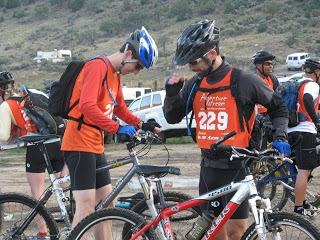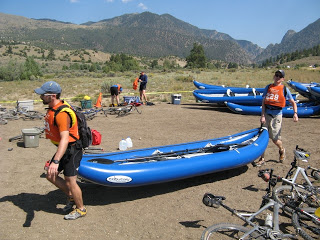 Me and my race partner, Tom, making final equipment checks before the start of the Adventure Xstream Vail 12-hour adventure race in 2007.
Me and my race partner, Tom, making final equipment checks before the start of the Adventure Xstream Vail 12-hour adventure race in 2007.
Part 2 of my series on Going the Distance is about pre-race nutrition. (If you missed Part 1 on nutrition for training, or want a refresher, you can read it here.) I like to divide the pre-race nutrition into two parts…the week leading up to a race, and the foods you eat immediately pre-race (night before and morning of).
In the week leading up to a race, there are two changes that go hand in hand – one a change in training, and the other, a change in diet. The change in training is known as the taper, whereby you gradually reduce your workload leading up to the race. This is designed to maintain your fitness, but also allow your muscles to rest and recover. The change in diet is the carbo load I precisely advised against in Part 1. Typically 2-3 days before a race, you want to purposefully pump the carbs in your diet…to 60% or more (as opposed to 40% while training).
These two shifts work in tandem to replenish glycogen stores in your muscles. In essence, you want to make sure that your fuel tanks start off at max full for race day.
On the other hand, you don’t want to shift your body too far away from its ability to efficiently draw on fats/triglycerides for energy, either. For that reason, as race day draws near in the wake of your carbo load, return to your normal balanced diet. This is important, not only for the carb/fat balance, but also because your normal diet is familiar. You don’t want to eat anything that could upset your body…nothing new or strange, nothing that sits too heavy, nothing that’s too difficult to digest.
For a meal the evening before a race, I’m a fan of combining a meat with a good source of carbs…say a steak with mashed potatoes and salad, or eggs with roasted potatoes and bacon, or chicken with rice and veggies. Then, the morning of the race, I eat a pretty normal breakfast – maybe some GF corn flakes or Rice Chex, two yogurts, some fresh fruit like a banana or an orange. I eat it a little earlier than usual…typically two hours before race start, so that I can be sure it’s fully digested. Then, as the race start approaches, I switch to my during-race nutrition, which often consists of energy chews or energy gels and a sports drink. But that’s for part 3, so more on that to come.
– Pete
